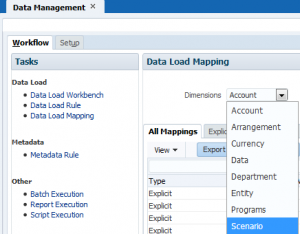In Oracle Hyperion Financial Data Quality Management, Enterprise Edition (FDMEE), when you setup a target application, a target dimension class needs to be specified for each dimension. Target dimension class is a property that is defined by dimension type. For example, if you have Period dimension, the dimension class is “Period”; for Account dimension, dimension class should be “Account”; Entity dimension with “Entity” class, and Scenario dimension goes for “Scenario” class.
“Category Mapping” is to be used as categorizing and mapping source system data to target application Scenario dimension member. After Scenario dimension is set for “Scenario” class, it will not show up in data load mapping. Instead, it is in the data load rule definition and decided by “Category Mapping.”
Now let’s look at a data integration requirement and how to avoid creating many data load rules.
In the source application, there are many scenarios, Actual, Budget, JanFcst, FebFcst … etc.. For every scenario, data needs to be loaded to the target application. By the regular way, the data load rules need to be created for each scenario. If there are 10 scenarios, you’ll have 10 DLRs; 20 scenarios, 20 DLRs and so on.
Let’s setup Scenario as a “Generic” dimension class:
The “Scenario” dimension will show up in the data load mapping:
Now let’s add the mapping for Scenario:
Note how source scenario is mapped to target scenario.
In defining data load rule, since “Category” is a must, we can define a dummy category named “Scenario”:
With this method, it doesn’t matter how many types of scenario exist in source/target system, you only need to define one data load rule for loading data!





